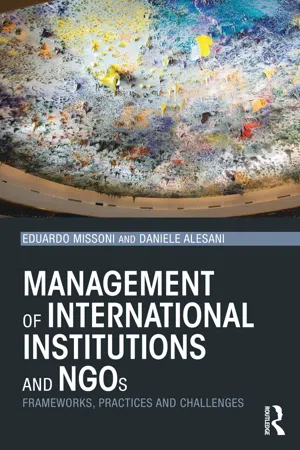
Management of International Institutions and NGOs
Frameworks, practices and challenges
- 440 pages
- English
- ePUB (mobile friendly)
- Available on iOS & Android
Management of International Institutions and NGOs
Frameworks, practices and challenges
About this book
International Institutions (IIs), International NGOs (INGOs) and Transnational Hybrid Organizations (THOs) play a hugely important role in the modern world economy. Despite having been studied by scholars from a range of disciplines, these organizations have never before been approached from a management perspective. This ambitious book analyzes the management challenges associated with international cooperation and sheds light on how these organizations have evolved as the political, economic and business environments have changed around them.
Covering an admirably broad canvas, the authors pursue two main objectives. Firstly, they explore the main management frameworks developed in the context of the corporate and national public/non-profit organizations and adapt them to the specificity of IIs and INGOs. This leads to the identification of a "tailored" approach to IO management based on their institutional and operational settings, stakeholder groups, core business, staff profile, and financial arrangements. Secondly, they "bring theory into practice" by linking frameworks to several case studies and best practices of organizations currently experimenting with management systems and tools, with case studies including the World Bank and the Gates Foundation.
This comprehensive textbook is a must-own resource for students and academics involved with studying and working with international organizations.
Frequently asked questions
- Essential is ideal for learners and professionals who enjoy exploring a wide range of subjects. Access the Essential Library with 800,000+ trusted titles and best-sellers across business, personal growth, and the humanities. Includes unlimited reading time and Standard Read Aloud voice.
- Complete: Perfect for advanced learners and researchers needing full, unrestricted access. Unlock 1.4M+ books across hundreds of subjects, including academic and specialized titles. The Complete Plan also includes advanced features like Premium Read Aloud and Research Assistant.
Please note we cannot support devices running on iOS 13 and Android 7 or earlier. Learn more about using the app.
Information
SECTION 1 The context
1 INTERNATIONAL INSTITUTIONS Classification and main characteristics
1.1 Introduction
1.2 Towards a definition of International Institutions
1.2.1 Minimal characteristics
- be based on a formal instrument of agreement between the governments of nation states;
- include three or more nation-states as parties to the agreement;
- possess a permanent secretariat performing ongoing tasks.
1.2.2 A more comprehensive definition
| Criterion | ‘Formal’ International Institution |
|---|---|
| Membership | |
| Number of states Mix | Three or more |
| Mix | Predominantly states; no veto on collective decision by non-state members |
| Representation | Representing central government or its sub-units |
| Governance | |
| Rules of governance | Specified in charter or constitutional act |
| Meetings | Routinized and meeting at regular intervals |
| Structure and organization | |
| HQ/Secretariat | Permanent |
| Staffing | Independent of any other organizations or any single state Non-symbolic; paid by the organization itself |
| Budgeting | |
| Funding mechanism | Financial resources periodically established and regularly available |
| Amount | Sufficient to cover adequate administrative support and core operations |
| Source | Majority funding not controlled by another organization or by one state |
| Source: Adapted from Volgy et al. (2006) | |
1.3 Possible classifications of International Institutions
1.3.1 Classifications based on membership, scope, sector and mandate
- Universal membership organizations, that have a widespread, geographically balanced membership, management and policy control.
- Intercontinental membership organizations, whose membership and focus exceed that of a particular continental region, although not to a degree justifying its inclusion in the previous type.
- Regionally defined membership organizations, whose members or preoccupations are restricted to a particular continent or sub-continental region.
- Cultural, linguistic, ethnic, religious, or historical organizations, open to members based on some cultural, linguistic, ethnic, religious, or historical link. Examples include the Commonwealth of Nations, La Francophonie, the Community of Portuguese Language Countries, the Latin Union, or the Organization of the Islamic Conference.
| Political affairs | Transportation | Employment |
|---|---|---|
| “General” development issues | Communication | Humanitarian assistance and disaster management |
| Statistics | Trade and development | Social development |
| Natural resources | Population | Culture |
| Energy | Human settlements | Science and technolog... |
Table of contents
- Cover Page
- Half-Title Page
- Title Page
- Copyright Page
- Table of Contents
- List of illustrations
- Foreword
- Acknowledgments
- List of Abbreviations
- Introduction
- SECTION 1 The context
- SECTION 2 Management of international cooperation
- SECTION 3 Management systems and reforms in International Organizations
- SECTION 4 Building and managing the organization’s profile
- Bibliography
- Index